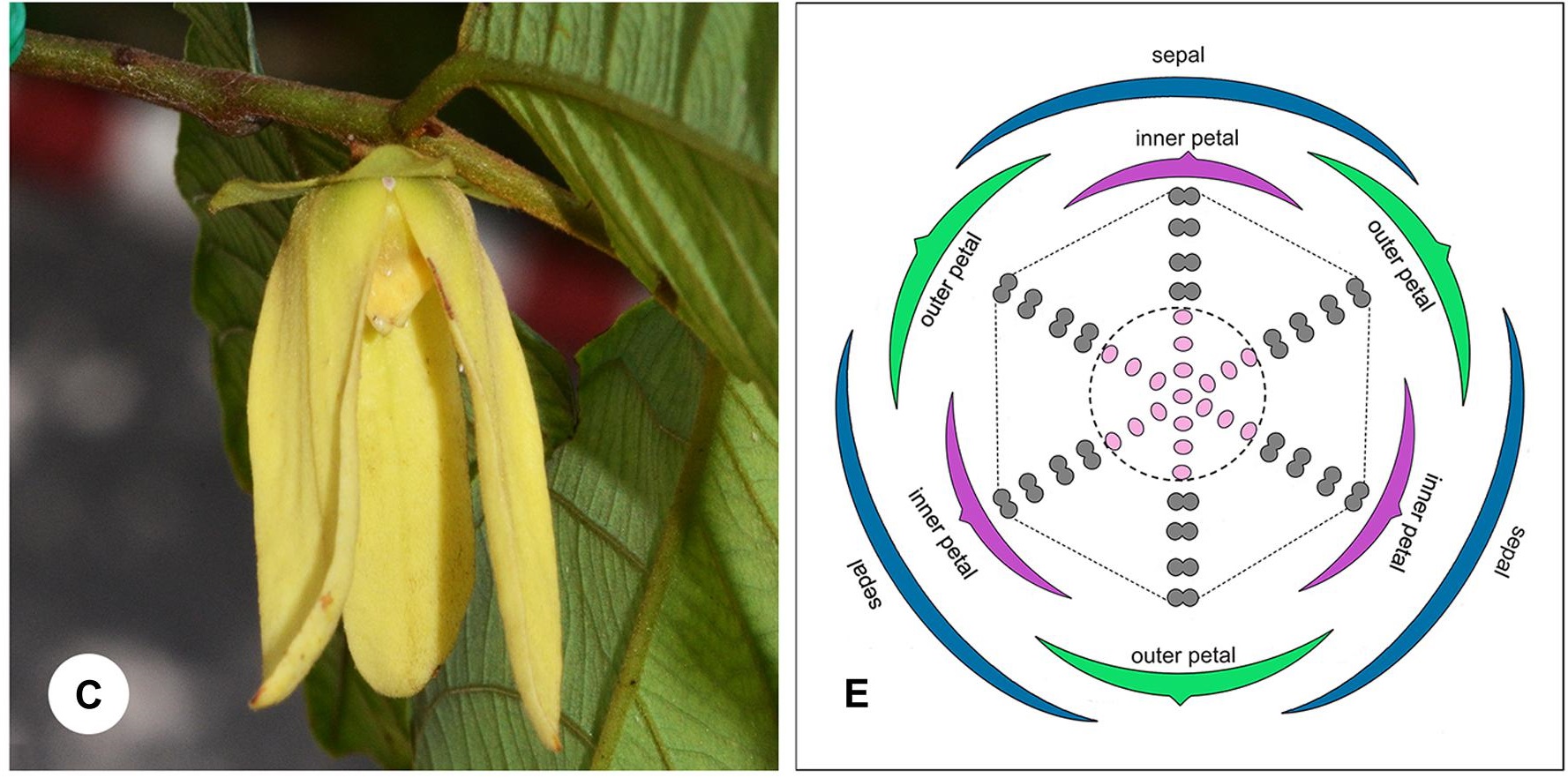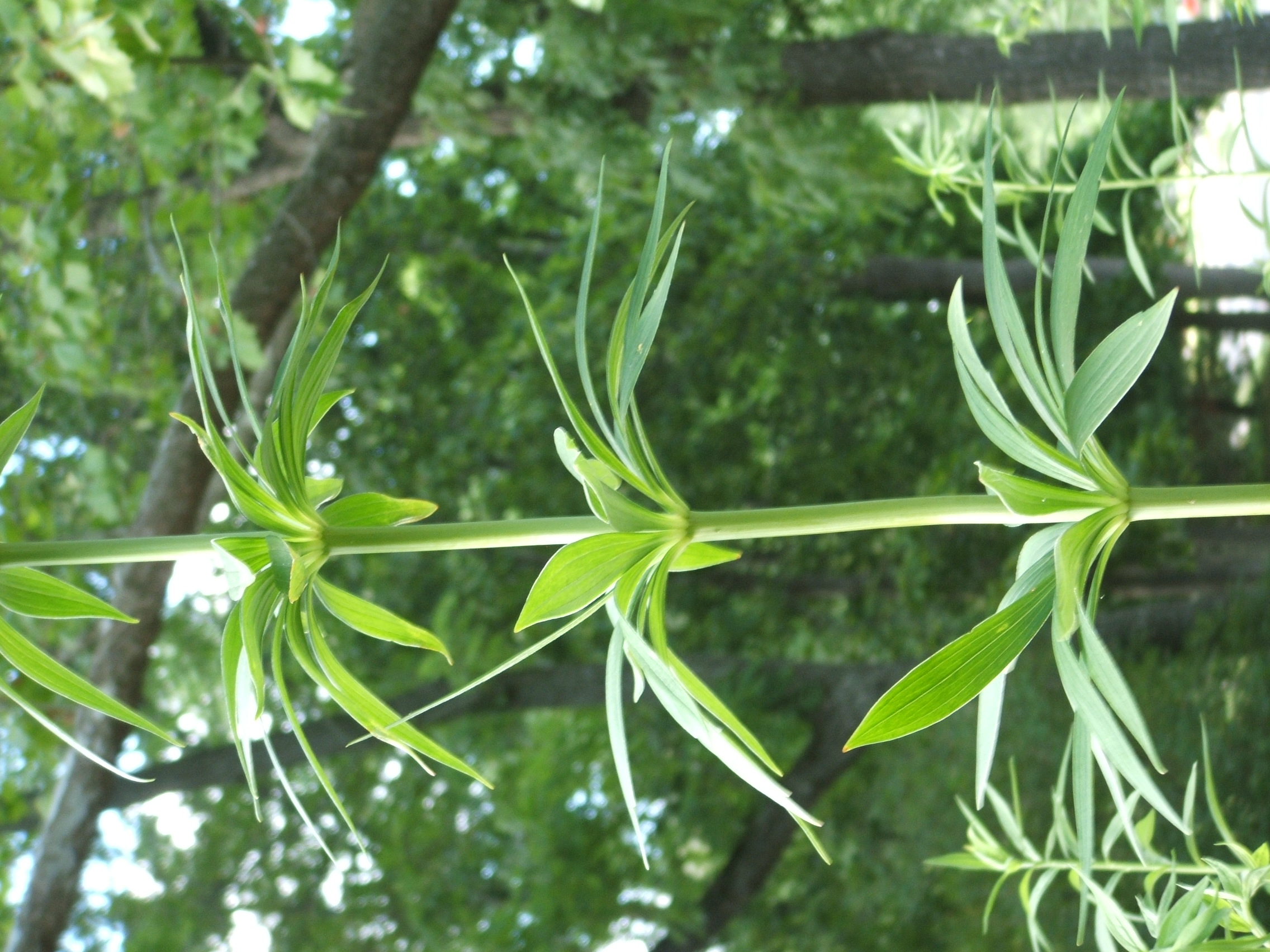Whorl (botany) on:
[Wikipedia]
[Google]
[Amazon]


 In botany, a whorl or verticil is a whorled arrangement of
In botany, a whorl or verticil is a whorled arrangement of


leaves
A leaf (: leaves) is a principal appendage of the stem of a vascular plant, usually borne laterally above ground and specialized for photosynthesis. Leaves are collectively called foliage, as in "autumn foliage", while the leaves, stem, ...
, sepal
A sepal () is a part of the flower of angiosperms (flowering plants). Usually green, sepals typically function as protection for the flower in bud, and often as support for the petals when in bloom., p. 106
Etymology
The term ''sepalum'' ...
s, petal
Petals are modified leaves that form an inner whorl surrounding the reproductive parts of flowers. They are often brightly coloured or unusually shaped to attract pollinators. All of the petals of a flower are collectively known as the ''corol ...
s, stamen
The stamen (: stamina or stamens) is a part consisting of the male reproductive organs of a flower. Collectively, the stamens form the androecium., p. 10
Morphology and terminology
A stamen typically consists of a stalk called the filament ...
s, or carpels
Gynoecium (; ; : gynoecia) is most commonly used as a collective term for the parts of a flower that produce ovules and ultimately develop into the fruit and seeds. The gynoecium is the innermost whorl of a flower; it consists of (one or more) ...
that radiate from a single point and surround or wrap around the stem or stalk. A leaf whorl consists of at least three elements; a pair of opposite leaves
In botany, phyllotaxis () or phyllotaxy is the arrangement of leaf, leaves on a plant stem. Phyllotactic spirals form a distinctive class of patterns in nature.
Leaf arrangement
The basic leaf#Arrangement on the stem, arrangements of leaves ...
is not called a whorl.
For leaves to grow in whorls is fairly rare except in plant species with very short internodes
A stem is one of two main structural axes of a vascular plant, the other being the root. It supports leaves, flowers and fruits, transports water and dissolved substances between the roots and the shoots in the xylem and phloem, engages in pho ...
and some other genera (''Galium
''Galium'' is a large genus of annual and perennial herbaceous plants in the family Rubiaceae, occurring in the temperate zones of both the Northern and Southern Hemispheres. Some species are informally known as bedstraw.
Over 600 species of ' ...
'', ''Nerium
''Nerium oleander'' ( ), commonly known as oleander or rosebay, is a shrub or small tree cultivated worldwide in temperate and subtropical areas as an ornamental and landscaping plant. It is the only species currently classified in the genus ...
'', '' Elodea'' etc.). Leaf whorls occur in some trees such as ''Brabejum stellatifolium
''Brabejum'' is a genus of a single species of large evergreen tree, ''Brabejum stellatifolium'' in the family Proteaceae, commonly called wild almond, bitter almond or ghoeboontjie. It is restricted in the wild to South Africa's Western Cape pro ...
'' and other species in the family Proteaceae
The Proteaceae form a family (biology), family of flowering plants predominantly distributed in the Southern Hemisphere. The family comprises 83 genus, genera with about 1,660 known species. Australia and South Africa have the greatest concentr ...
(e.g., in the genus ''Banksia
''Banksia'' is a genus of around 170 species of flowering plants in the family Proteaceae. These Australian wildflowers and popular garden plants are easily recognised by their characteristic flower spikes, and woody fruiting "cones" and head ...
''). In plants such as these, crowded internodes within the leaf whorls alternate with long internodes between the whorls.
The morphology
Morphology, from the Greek and meaning "study of shape", may refer to:
Disciplines
*Morphology (archaeology), study of the shapes or forms of artifacts
*Morphology (astronomy), study of the shape of astronomical objects such as nebulae, galaxies, ...
of most flower
Flowers, also known as blooms and blossoms, are the reproductive structures of flowering plants ( angiosperms). Typically, they are structured in four circular levels, called whorls, around the end of a stalk. These whorls include: calyx, m ...
s (called cyclic flower
A cyclic flower is a flower type formed out of a series of whorls; sets of identical organs attached around the axis at the same point. Most flowers consist of a single whorl of sepals termed a calyx; a single whorl of petals termed a corolla; ...
s) is based on four types of whorls:
# The calyx: zero or more whorls of sepals at the base
# The corolla: zero or more whorls of petals above the calyx
# The androecium
The stamen (: stamina or stamens) is a part consisting of the male reproductive organs of a flower. Collectively, the stamens form the androecium., p. 10
Morphology and terminology
A stamen typically consists of a stalk called the filament ...
: zero or more whorls of stamens, each comprising a filament and an anther
# The gynoecium
Gynoecium (; ; : gynoecia) is most commonly used as a collective term for the parts of a flower that produce ovules and ultimately develop into the fruit and seeds. The gynoecium is the innermost whorl (botany), whorl of a flower; it consists ...
: zero or more whorls of carpels, each consisting of an ovary
The ovary () is a gonad in the female reproductive system that produces ova; when released, an ovum travels through the fallopian tube/ oviduct into the uterus. There is an ovary on the left and the right side of the body. The ovaries are end ...
, a style
Style, or styles may refer to:
Film and television
* ''Style'' (2001 film), a Hindi film starring Sharman Joshi, Riya Sen, Sahil Khan and Shilpi Mudgal
* ''Style'' (2002 film), a Tamil drama film
* ''Style'' (2004 film), a Burmese film
* '' ...
, and a stigma
A flower lacking any of these floral structures is said to be ''incomplete'' or ''imperfect''. Not all flowers consist of whorls since the parts may instead be spirally arranged, as in the family Magnoliaceae
The Magnoliaceae () are a flowering plant family, the magnolia family, in the order Magnoliales. It consists of two genera: '' Magnolia'' and ''Liriodendron'' (tulip trees).
Unlike most angiosperms, whose flower parts are in whorls (rings), ...
.
See also
*Cyclic flower
A cyclic flower is a flower type formed out of a series of whorls; sets of identical organs attached around the axis at the same point. Most flowers consist of a single whorl of sepals termed a calyx; a single whorl of petals termed a corolla; ...
* Merosity Merosity (from the greek "méros," which means "having parts")) refers to the number of component parts in a distinct whorl of a plant structure. The term is most commonly used in the context of a flower where it refers to the number of sepals in a ...
* Phyllotaxis
In botany, phyllotaxis () or phyllotaxy is the arrangement of leaf, leaves on a plant stem. Phyllotactic spirals form a distinctive class of patterns in nature.
Leaf arrangement
The basic leaf#Arrangement on the stem, arrangements of leaves ...
References
Plant morphology {{plant-morphology-stub